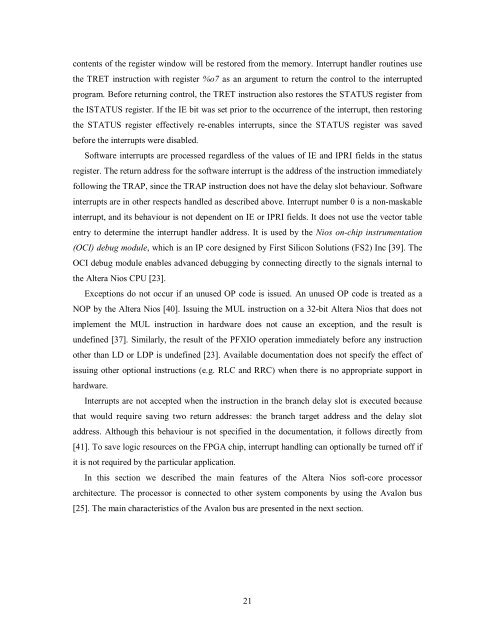Soft-Core Processor Design - CiteSeer
Soft-Core Processor Design - CiteSeer
Soft-Core Processor Design - CiteSeer
Create successful ePaper yourself
Turn your PDF publications into a flip-book with our unique Google optimized e-Paper software.
contents of the register window will be restored from the memory. Interrupt handler routines use<br />
the TRET instruction with register %o7 as an argument to return the control to the interrupted<br />
program. Before returning control, the TRET instruction also restores the STATUS register from<br />
the ISTATUS register. If the IE bit was set prior to the occurrence of the interrupt, then restoring<br />
the STATUS register effectively re-enables interrupts, since the STATUS register was saved<br />
before the interrupts were disabled.<br />
<strong>Soft</strong>ware interrupts are processed regardless of the values of IE and IPRI fields in the status<br />
register. The return address for the software interrupt is the address of the instruction immediately<br />
following the TRAP, since the TRAP instruction does not have the delay slot behaviour. <strong>Soft</strong>ware<br />
interrupts are in other respects handled as described above. Interrupt number 0 is a non-maskable<br />
interrupt, and its behaviour is not dependent on IE or IPRI fields. It does not use the vector table<br />
entry to determine the interrupt handler address. It is used by the Nios on-chip instrumentation<br />
(OCI) debug module, which is an IP core designed by First Silicon Solutions (FS2) Inc [39]. The<br />
OCI debug module enables advanced debugging by connecting directly to the signals internal to<br />
the Altera Nios CPU [23].<br />
Exceptions do not occur if an unused OP code is issued. An unused OP code is treated as a<br />
NOP by the Altera Nios [40]. Issuing the MUL instruction on a 32-bit Altera Nios that does not<br />
implement the MUL instruction in hardware does not cause an exception, and the result is<br />
undefined [37]. Similarly, the result of the PFXIO operation immediately before any instruction<br />
other than LD or LDP is undefined [23]. Available documentation does not specify the effect of<br />
issuing other optional instructions (e.g. RLC and RRC) when there is no appropriate support in<br />
hardware.<br />
Interrupts are not accepted when the instruction in the branch delay slot is executed because<br />
that would require saving two return addresses: the branch target address and the delay slot<br />
address. Although this behaviour is not specified in the documentation, it follows directly from<br />
[41]. To save logic resources on the FPGA chip, interrupt handling can optionally be turned off if<br />
it is not required by the particular application.<br />
In this section we described the main features of the Altera Nios soft-core processor<br />
architecture. The processor is connected to other system components by using the Avalon bus<br />
[25]. The main characteristics of the Avalon bus are presented in the next section.<br />
21














